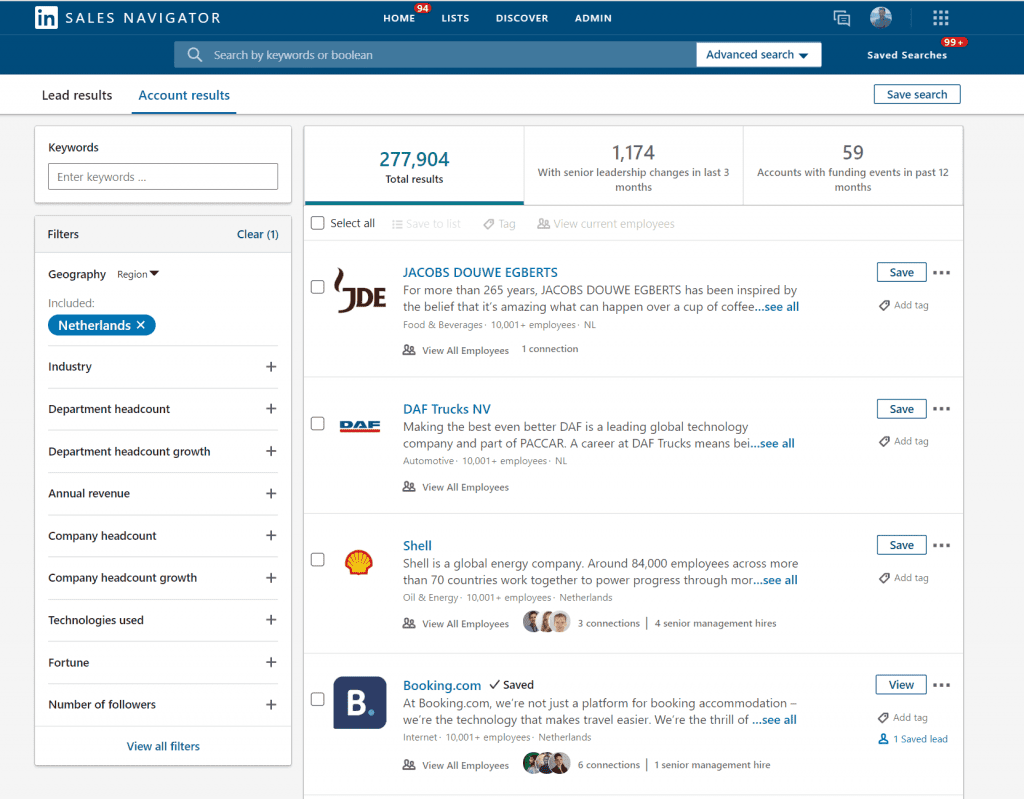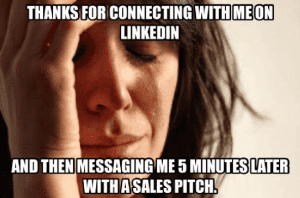Updated on June 9, 2022
(4 Reasons Why you shouldn’t rely your B2B sales solely on LinkedIn)
When you think of b2b Sales, you instantly think of LinkedIn. In the last 5 years, Linkedin reached its peak in b2b sales for all industries and company sizes. Most, if not all b2b companies build up teams of Sales reps to find clients (independent of the stage of their development), and the LinkedIn Sales Navigator is a must, both as a skill and as a tool.
Unfortunately, many companies think they can build up their lead base only with the LinkedIn Sales Navigator. And, here they start giving efforts, spending money and resources only to have access to LinkedIn’s company and contact database, not aware that they are depending on the limited number of organizations registered there.

I must admit, LinkedIn Prospecting (when done right) is a powerful way to attract b2b leads and connect with prospects. It has a very large amount of data to provide to the sales teams and it’s quite accurate, as the users update it themselves.
This is quite good for a start, however not enough to align your lead demand with your client conversion.
So what are the reasons why you shouldn’t only rely on LinkedIn for your sales and marketing efforts?
TL:DR
- Missing out on a large amount of companies
- LinkedIn is “heavily” used -> automation, recruiter etc
- The main focus on B2B -> Missing a lot of B2C Industries
- Older / less-tech savvy people are not using LinkedIn.
Let’s take one case:
The LinkedIn data limit
Let’s say you are a startup in the Netherlands, a software project trying to swim along with the big fishes. In the beginning, you need people to hear about you, so you build up a team of couple of Sales Reps and you orient their daily tasks towards LinkedIn as their main tool for finding leads.
You can only go so far with 280K companies, that LinkedIn lists as companies in the Netherlands. This is in the phase where you haven’t even started with the industry or region segmentation, so the number will get lower.
On the other hand, if you check the company registries, they give a number of 3.1M registered entities in the Netherlands. If we do the math, LinkedIn gives you only 9% of the total amount of companies…

Let’s go even further:
LinkedIn field of use
According to LinkedIn stats, there are 90 million LinkedIn senior-level influencer users, and 63 million were in decision-making positions. These would usually be the ones that are targeted the most.
But, there are only 63 million decision-makers you can reach out to on LinkedIn. You and the rest 11 million companies registered there. 
This is where LinkedIn’s data gets exhausted and even gets irritating and spammy for most people. Not to forget about all the automated InMails that are sent out (for which you also spend extra money) and the other perspectives of the platform. In fact, LinkedIn tagged themselves on their Linkedin Company Profile as Online Professional Network, Jobs, People Search, Company Search, Address Book, Advertising, Professional Identity, and Group Collaboration, which explains the heavy usage in different fields.
Let’s dig deeper:
The LinkedIn B2B orientation
What’s your niche? What’s your target audience? What’s your product about? You should ask yourself all of these before you base all your sales efforts on LinkedIn.
The Main focus on LinkedIn is the B2B world. And yes, you can find quite a large number of people working in the same or similar field to you for collaboration and potential clients.
But, what happens if you want to reach out to B2C industries with your solution?
Often traditional companies are not fully available on LinkedIn like manufacturing or agriculture companies. This is where you need to rely on social media or the yellow pages to find these companies. Many times you’ll end up manually searching for them on the internet. B2B data for these companies can better be found via their websites.
To cut off the manual work, but to still have a LinkedIn-like filtering system, it’s better to work with company data providers, that help you here with vast amounts of info about a company for your target reach out.
Let’s check another perspective:
The LinkedIn age trends
What kind of people do you see on LinkedIn? Almost a quarter of LinkedIn users are aged 18 to 29. And the percentage falls lower for the more mature aged groups. Although this is quite good, statistics like Fortune 500 show that the average age of an experienced CEO, which is most of the time our targeted decision-maker, is 58 years.
So, if you are looking to find more mature leads you can find only 21 percent of the LinkedIn users, that are about or above 60. The reason for this is that people of this age have long-established careers and focus on their business rather than the new technology developments and social trends.
This group of decision-makers usually has very high purchasing power, but also specific needs. So, it’s necessary to hyper-target your outreach to hit these deals.
Back to the point:
How can you connect to the other 91% of companies nevertheless?
You can start by finding a relevant, but not limited source of leads.
Starting with all LinkedIn data and combining it with the data from the company registries, online presence, and other sources you can have an endless source of leads for your sales efforts. But all this would require endless manual work.
On the other hand, in the past 5-10 years as LinkedIn grew, database providers having other data, grew as well. The so-called sales enablement tools have helped teams not to rely only on LinkedIn, but offer them an alternative to LinkedIn’s repetitive data. Next to the standard chamber of commerce data, they pull data right away from a companies website like employees, contact details, technographic information, or content updates which LinkedIn does not provide.
We can see that LinkedIn is a remarkable platform that’s definitely worth using and setting up your lead base. But it is more like fishing in a pond, rather than in the big sea.
The expectation from your sales team should correspond with the resources you provide them with.


